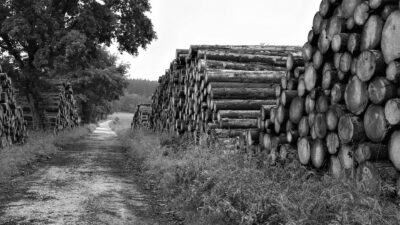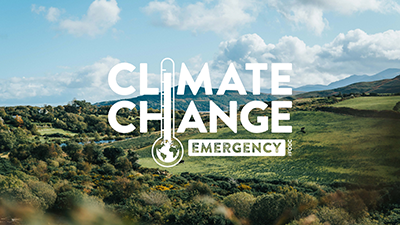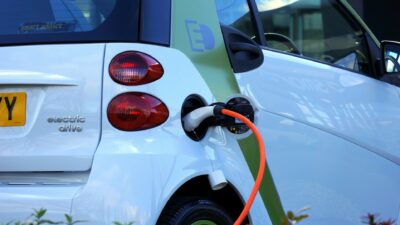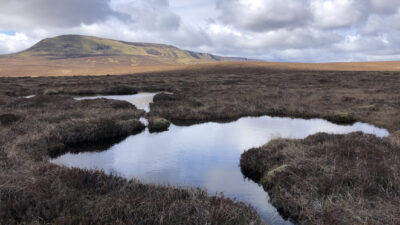Energy Management
Energy and Water Management at Fermanagh Omagh District Council
At Fermanagh Omagh District Council, we understand the importance of energy and water as essential resources for a sustainable economy.
We also recognise the crucial role that natural resource management plays in responding to the challenges of Climate Change and rising fuel costs.

Tracking our Energy and Water Use
We collect and report on electricity, oil, gas, biomass and water consumption data from a combination of meter readings and invoice data.
Being an organisation with a large number of assets, the monitoring of energy and water consumption is essential to ensure an accurate and cost-effective assessment of our energy and water usage.
| Utility | Type | Data Collection | Scope |
|---|---|---|---|
| Electricity | Manual data submissions via JotForm, measured in kWh | Monthly per site | Entire Estate |
| Oil | Monthly data submissions via JotForm, measured in litres | Monthly per site | Entire Estate |
| Biomass | Monthly data submissions via JotForm, measured in kilograms/ kWh | Monthly per site | Entire Estate |
| Gas | Monthly data submissions via JotForm, measured in litres | Monthly per site | Entire Estate |
| Water | Monthly data submissions via JotForm, measured in m3. | Monthly per site | Entire Estate |
We report on our energy consumption on a quarterly basis, using all the data received in the previous 3 months and comparing it to previous months.
These reports can then inform where to action changes where economically feasible, to help support our energy conservation strategies.
Display Energy Certificates
A Display Energy Certificate (DEC) shows the energy performance of a building based on its actual annual energy consumption and the CO2 emissions that result from that energy use.
Under the Energy Performance of Buildings Directive Northern Ireland, we have to show a Display Energy Certificate (DEC) in a prominent place in buildings occupied by public authorities and institutions providing public services.
These buildings have a total useful floor area that exceeds 250m2, and are frequently visited by the public.
The purpose of introducing DECs is to raise public awareness of energy use and to inform visitors to public buildings about the energy use of a building.
They provide an energy rating of the building from A to G, where A is very efficient and G is the least efficient. The advisory report contains recommendations for improving the energy performance of the building.
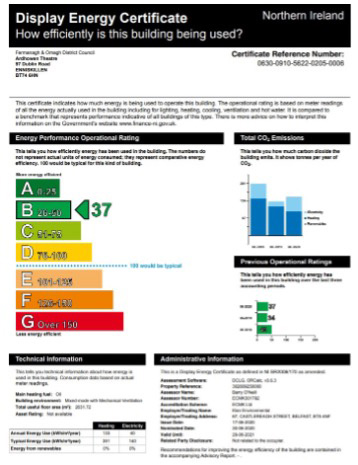
Our Greenhouse Gas Emissions
At Fermanagh Omagh District Council, we recognise that greenhouse gas (GHG) emissions are the main driver for Climate Change and are a key contributor to the Councils environmental footprint.
Our role
We recognise our role in reducing emissions and setting targets with respect to CO2 emissions reduction. In February 2021, Fermanagh Omagh District Council released its Climate Change and Sustainable Development Strategy and in November 2021, launched its Climate Change and Sustainable Development Action Plan, making it the first Council in Northern Ireland to do so. This action plan explains how the Council will respond to the climate emergency and transition to a sustainable and inclusive economy and highlights a number of ambitious decarbonisation milestones.
2031
Net Zero Emission Fleet
In 2021, FODC’s Carbon Baseline Report was produced, covering the 2019/2020 financial year. This covered our Scope 1 and Scope 2 emissions.
Scope 1
Scope 1 emissions, also known as direct emissions, are emissions produced by council controlled sources.
Examples of scope 1 emissions:
- Fossil fuels combusted in boilers for heat production
- Fossil fuels combusted in vehicle engines
Scope 2
Scope 2 emissions, also known as indirect emissions, are emissions that can indirectly be attributed to the council, even though they are not produced by council owned sources.
Examples of Scope 2 emissions:
- Carbon emissions produced as a result of the electricity generation process
Scope 3
Scope 3 emissions, are emissions produced as a consequence of the activities of the council, but occur from sources not owned or controlled by it.
Examples of scope 3 emissions:
- transmission and distribution (generation of electricity consumed in a T&D system)
- outsourced transport activities (transportation of waste, transport service for schools)
- business mileage
Total GHG Emissions
In 2019/2020, Fermanagh Omagh District Council produced 4219 Tonnes CO2 (Scope 1 and 2 emissions). The breakdown of these emissions can be seen in the graph below.
| Source | Tonnes CO2e | Pct % |
|---|---|---|
| Gas | 36 | 0.85 |
| Bioenergy | 38 | 0.90 |
| Fuel Oil | 1,213 | 28.75 |
| Council Vehicles | 1,544 | 36.60 |
| Electricity | 1,388 | 32.90 |
| 4,219 | 100.00 |
Estate CO2 Production by Asset Type
| Asset Type | Total Emissions (tCO2e) | Pct % |
|---|---|---|
| Animal Management | 9.00 | 0.34 |
| Changing Room | 8.50 | 0.32 |
| Community Centre | 93.70 | 3.50 |
| Leisure Centre | 1,075.30 | 40.20 |
| MUGA | 8.50 | 0.32 |
| Museum | 173.80 | 6.50 |
| Office | 445.30 | 16.65 |
| Public Convenience | 90.80 | 3.39 |
| Theatre | 303.50 | 11.35 |
| Visitors Centre | 39.70 | 1.48 |
| Waste and Recycling | 366.50 | 13.70 |
| Other | 60.00 | 2.24 |
| 2,674.60 | 100.00 |
Emissions Reduction Trajectory
The chart below shows FODC's annual Scope 1 and 2 emissions. As of 2023/24, FODC have managed to reduce their emission by 11.61% compared to the 2019/20 baseline year. This was achieved through 3 main pathways:
1) A reduction in overall energy use through behavioural change and energy efficiency interventions in the Council estate
2) Sustainable fuels (HVO) trials and additional investment in electric vehicles in the Councils fleet.
3) Decarbonisation of the Northern Ireland electricity grid
Carbon Literacy Training
Fermanagh Omagh District Council are working in conjunction with Climate Northern Ireland to deliver carbon literacy training to its staff members. To date, 16 staff member and 7 Councillors have completed the course, with plans to make this available to more staff in the coming months, subject to course availability.
Potential Improvements
In the coming years, processes will be put into place to include Scope 3 emissions, which will give a true indication of the entire GHG production of the councils operations.
Fermanagh Omagh Energy Management Policy 2020 - 2030
At Fermanagh Omagh District Council, we continue to make efforts to reduce our energy consumption, through data monitoring, behavioural changes, control systems and also through capital investment in energy efficiency and renewable energy production. Fermanagh Omagh District Councils Energy Management Policy 2020 – 2030 outlines the Council commitment to reducing its energy use, and the associated carbon emissions and has 5 key strategic objectives;
- Improve Energy and Utility Management across Council’s Estate
- Reduce emissions from day-to-day operations
- Commitment to sustainable building practices for construction projects
- Increase contribution of renewable energy generated on-site
- Sustainable leadership and behaviour
Energy Management Policy Commitments
The policy also outlines a series of ambitious Energy and Water reduction commitments including:
- 40%* reduction in CO2 emissions by 2030
- Improvement to a minimum C-rating of all Council buildings currently requiring Display Energy Certification (DEC) by 2025
- 3% of heated floor area of Council Estate/Buildings to be refurbished per annum to improve energy efficiency
- 33%* reduction in electricity consumption by 2030
- 33%* reduction in purchased heat consumption by 2030
- 25%* reduction in mains water consumption by 2030
- 100%* increase in on-site renewable energy output (kWh) by 2025
- 100% of all new Council staff to be given training on energy awareness as part of their induction programme
*Compared to 2019/2020 baseline year.
Green Electricity Tariff
Fermanagh Omagh District Council will procure 100% of their electricity supply from renewable energy sources.


